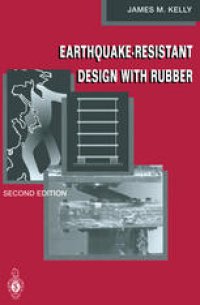
Ebook: Earthquake-Resistant Design with Rubber
Author: James M. Kelly (auth.)
- Tags: Building Construction, Engineering Design
- Year: 1997
- Publisher: Springer-Verlag London
- Edition: 2
- Language: English
- pdf
Base isolation technology offers a cost-effective and reliable strategy for mitigating seismic damage to structures. The effectiveness of this new technology has been demonstrated not only in laboratory research, but also in the actual response of base-isolated buildings during earthquakes. Increasingly, new and existing buildings in earthquake-prone regions throughout the world are making use of this innovative strategy. In this expanded and updated edition, the design methods and guidelines associated with seismic isolation are detailed. The main focus of the book is on isolation systems that use a damped natural rubber. Topics covered include coupled lateral-torsional response, the behavior of multilayer bearings under compression and bending, and the buckling behavior of elastomeric bearings. Also featured is a section covering the recent changes in building code requirements.
Base isolation technology offers a cost-effective and reliable strategy for mitigating seismic damage to structures. The effectiveness of this new technology has been demonstrated not only in laboratory research, but also in the actual response of base-isolated buildings during earthquakes. Increasingly, new and existing buildings in earthquake-prone regions throughout the world are making use of this innovative strategy. In this expanded and updated edition, the design methods and guidelines associated with seismic isolation are detailed. The main focus of the book is on isolation systems that use a damped natural rubber. Topics covered include coupled lateral-torsional response, the behavior of multilayer bearings under compression and bending, and the buckling behavior of elastomeric bearings. Also featured is a section covering the recent changes in building code requirements.
Base isolation technology offers a cost-effective and reliable strategy for mitigating seismic damage to structures. The effectiveness of this new technology has been demonstrated not only in laboratory research, but also in the actual response of base-isolated buildings during earthquakes. Increasingly, new and existing buildings in earthquake-prone regions throughout the world are making use of this innovative strategy. In this expanded and updated edition, the design methods and guidelines associated with seismic isolation are detailed. The main focus of the book is on isolation systems that use a damped natural rubber. Topics covered include coupled lateral-torsional response, the behavior of multilayer bearings under compression and bending, and the buckling behavior of elastomeric bearings. Also featured is a section covering the recent changes in building code requirements.
Content:
Front Matter....Pages i-xi
Seismic Isolation for Earthquake-Resistant Design....Pages 1-18
Vibration Isolation....Pages 19-34
Seismic Isolation....Pages 35-59
Extension of Theory to Buildings....Pages 61-76
Earthquake Regulations for Seismically Isolated Structures....Pages 77-99
Coupled Lateral-Torsional Response of Seismically Isolated Buildings....Pages 101-130
Behavior of Multilayered Bearings Under Compression and Bending....Pages 131-159
Buckling Behavior of Elastomeric Bearings....Pages 161-189
Design Process for Multilayered Elastomeric Bearings....Pages 191-213
Back Matter....Pages 215-243
Base isolation technology offers a cost-effective and reliable strategy for mitigating seismic damage to structures. The effectiveness of this new technology has been demonstrated not only in laboratory research, but also in the actual response of base-isolated buildings during earthquakes. Increasingly, new and existing buildings in earthquake-prone regions throughout the world are making use of this innovative strategy. In this expanded and updated edition, the design methods and guidelines associated with seismic isolation are detailed. The main focus of the book is on isolation systems that use a damped natural rubber. Topics covered include coupled lateral-torsional response, the behavior of multilayer bearings under compression and bending, and the buckling behavior of elastomeric bearings. Also featured is a section covering the recent changes in building code requirements.
Content:
Front Matter....Pages i-xi
Seismic Isolation for Earthquake-Resistant Design....Pages 1-18
Vibration Isolation....Pages 19-34
Seismic Isolation....Pages 35-59
Extension of Theory to Buildings....Pages 61-76
Earthquake Regulations for Seismically Isolated Structures....Pages 77-99
Coupled Lateral-Torsional Response of Seismically Isolated Buildings....Pages 101-130
Behavior of Multilayered Bearings Under Compression and Bending....Pages 131-159
Buckling Behavior of Elastomeric Bearings....Pages 161-189
Design Process for Multilayered Elastomeric Bearings....Pages 191-213
Back Matter....Pages 215-243
....